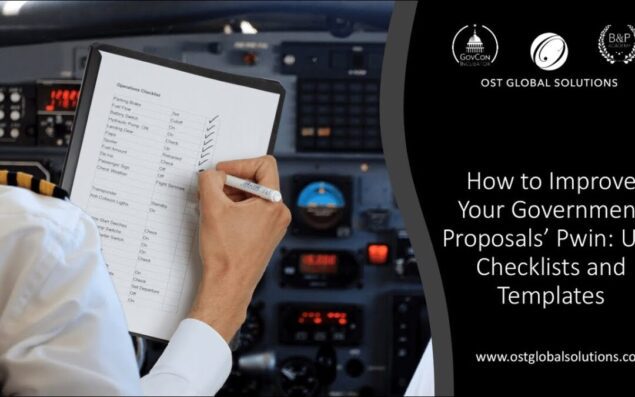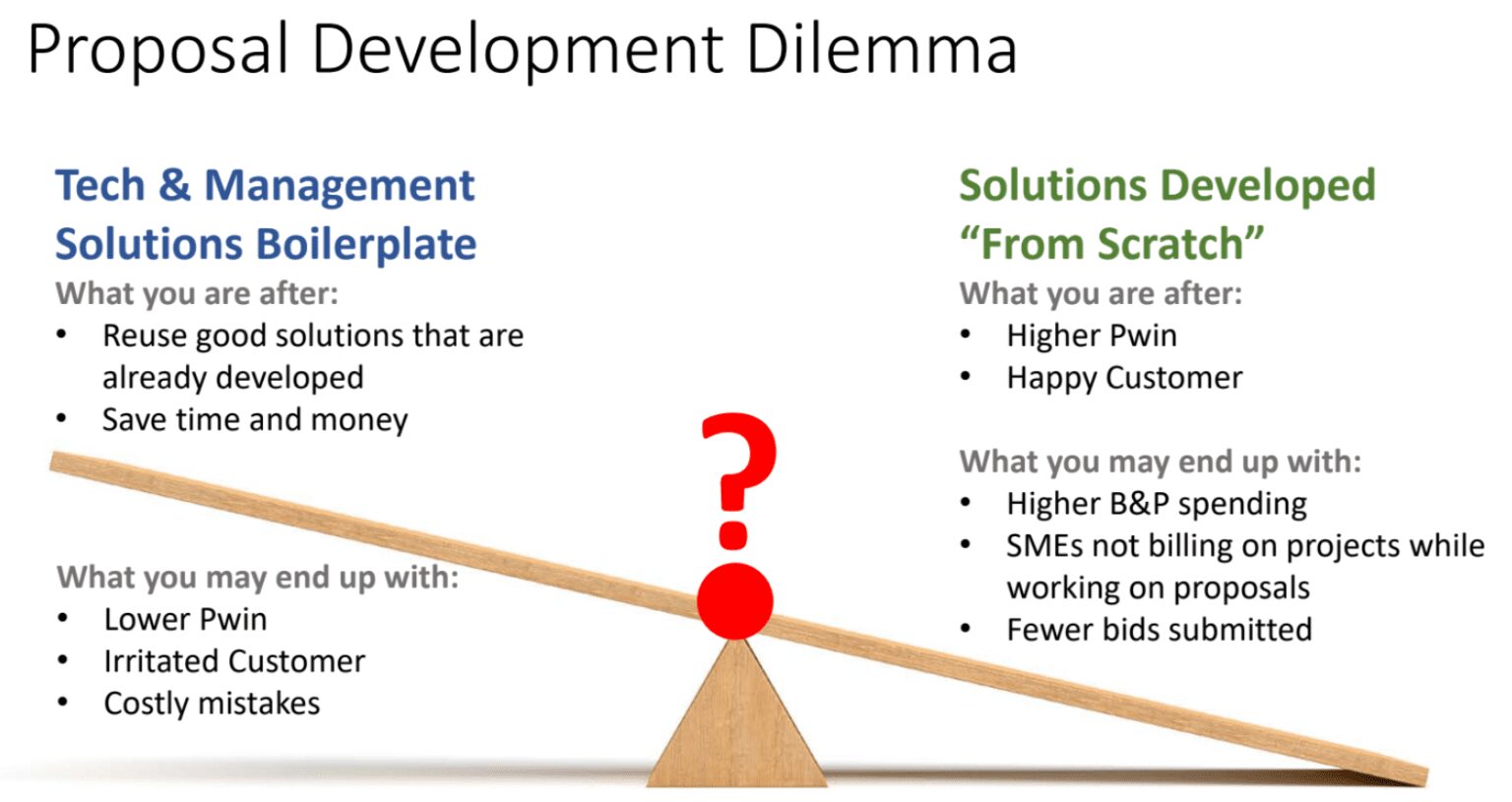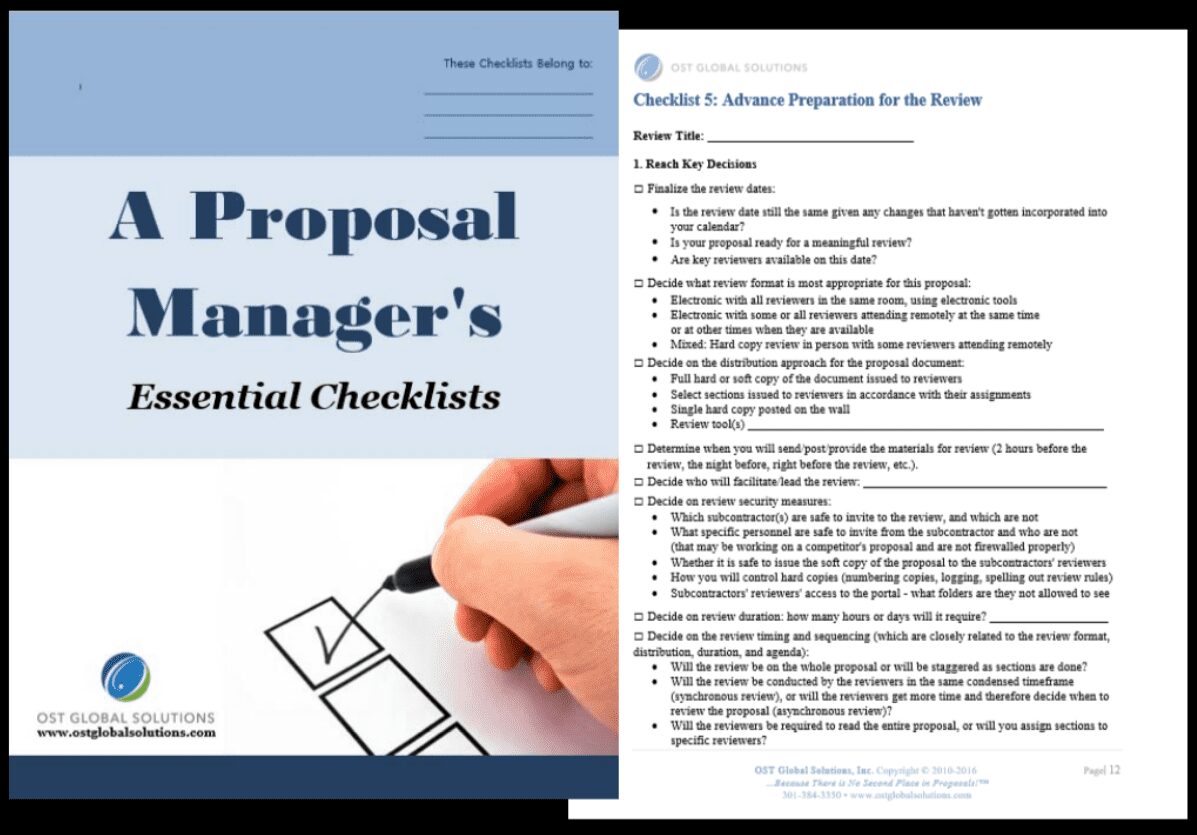In part six of our Improving Your Government Proposals’ Pwin series video we encourage you to use checklists and templates to improve your win probability (Pwin). Checklists and templates, when appropriately structured and used, speed up your proposal development process. Checklists also improve your Pwin by helping you duplicate proven processes without having to resort to using boilerplate.
In part two of this series, we addressed why reusing previous proposals decreases your Pwin. However, creating checklists based on the successful thought processes used to win federal contracts will increase it. Read on to find out how you can incorporate this strategy.
The Proposal Development Dilemma (Using Proposal Boilerplate vs. Brainstorming During Capture and Writing Proposals From Scratch)
Many proposal professionals wonder: how do we leverage the proposal boilerplate and reuse good solutions we’ve already developed, to save time and money while submitting more proposals?
Most experienced proposal professionals know that using boilerplate lowers your Pwin when compared to the custom-developed proposal, but would like to reuse and recycle, as it feels like a smart way to increase proposal ROI.
Boilerplate Proposal Solutions May Save You Time, but Never Increase Your Win Probability
You may wrestle with the temptation to reuse portions or entire management and technical sections from previous proposals. After all, creating every solution from scratch flies in the face of efficiency. However, while you intend to save time and money, you keep hearing that boilerplate proposal sections never improve your proposal Pwin. You usually end up with:
- Cringe-worthy leftover information from past proposals that didn’t get caught in the editing process. Sometimes it may be even another customer’s name or organizational constructs. These can be hard to notice during an intense proposal development process.
- Writers getting wrapped around the axel while tailoring sections (usually more time than your writer would have spent writing it from scratch).
- Proposal sections that “sort of” sound right and inhibit tailored customer solution development. These boilerplate sections may sound great, especially if they come from a proposal that won. A stellar proposal might not be the reason you won though. As we said in part one of this series, you might have simply “submitted the best of the other bad proposals.” Your poor proposal may have not been as badly written as the others, and the price was right.
While you’re aiming to reuse good solutions from your proposal library, speed up your proposal development process, and save money, you may get a lower win probability (Pwin), an irritated customer, and costly mistakes. Not to mention, the money you save reusing your proposal becomes a moot point when your competitor receives the contract award.
Government evaluators can spot boilerplate proposals from a mile away. Let’s face it, so can you. When receiving boilerplate, evaluators may feel insulted and disrespected. We referred to similar emotions and thoughts when we discussed why you should always prepare a tailored capability statement for each potential Government customer.
Your proposal will likely contain details inapplicable for your current pursuit, and error and typos. Mistakes like that indicate to the customer that you’re unprepared, disorganized, or careless.
Develop “From Scratch” Proposal Solutions Using Checklists
When you develop all of your solutions from the ground up, your heart is in the right place. Your main priorities are a happy customer and a higher Pwin. The upside is the higher win rate and customer respect.
You’ll normally obtain your goal, but it comes with costly side effects, like:
- Higher bid and proposal (B&P) spending, as it costs more to gather your team for brainstorming during capture and proposal development.
- Subject Matter Experts are being pulled away from their cash-generating “daytime” jobs. Your SMEs can’t bill the customer while working on capture and proposals.
- Fewer bids were submitted because of the capital-intensive investment into each proposal effort. You can’t churn out that many proposals with such an expensive level of effort. If you don’t bid, you don’t win.
Proposal professionals often wonder if they can find a happy medium between boilerplate proposals (which lower Pwin), and “from scratch” solutions (which can be costly).
How Do You Balance Boilerplate and “From Scratch” Proposal Development?
At this point, you have to wonder “Is there a balance between the two extremes? Can’t I have the best of both worlds? Can I reuse and recycle, and create a tailored solution for the customer?”
Happily, we can say “yes” to your questions. There are three best practices we recommend:
- Create prebuilt processes, tools, and templates with pre-set styles for every type of pursuit and solicitation that you tend to go after. In another article, we explored why having various custom business development, capture, and proposal management processes improve your Pwin. The opportunity you’re pursuing should dictate which toolset you use to save you time and effort.
- Have a past performance, resumes, and graphics library. You should consistently update your library, which will allow you to reuse the information easily. You must always customize your graphics for each proposal effort, but you can use the graphics in your library for inspiration.
- Use checklists for every step of your capture and proposal processes, especially brainstorming. Checklists are the solution to the dilemma.
Use Checklists and Templates to Save Time While Raising Your Pwin
Once you create effective checklists, you’ve found the sweet spot between boilerplate and brainstorming. Your checklist should remind your team of:
- Questions that need to be answered for this opportunity;
- Decisions that need to be made when formulating a solution for a particular approach; and
- Brilliant past solutions that may apply to this customer, time, and circumstance but upon discussion and tailoring, will likely look completely different as applied to this opportunity).
Keep in mind, your checklists need to evolve as you develop new solutions.
Generally, you have two types of checklists: those that help you manage the process without skipping steps (Capture and Proposal Management Checklists), and those that provide a structure for critical thinking and reminders of past solutions (Brainstorming Checklists).
Capture and Proposal Management Checklist Examples
You have some questions to consider as you work on developing your own capture and proposal management checklists:
- How do you make sure you don’t forget critical process steps?
- How do you ensure you quickly sail through the process each time?
- What is your process for delegating tasks to your team members?
Examples of proposal management checklists include:
- Kicking off your proposal effort.
- Preparing for and conducting Pink Team, Red Team, or Gold Team reviews.
- Preparing your proposal for submission.
OST offers training in advanced capture and proposal management techniques, like creating essential checklists; we also create custom checklists for your company.
Here are some additional examples of processes you can create checklists and templates for:
- Teaming checklist
- What do you look for in a teammate?
- Evaluate your strategic options
- Note which steps you should never skip in this process
- Editing checklist
Brainstorming Checklists
These types of checklists can improve your speed during solution development:
- Content development checklists for management approach
- Content development checklist for every type of technical approach your company offers
- Ex: if you provide help desk and service desk solutions, you can create a checklist for the types of things your team should brainstorm on to create a fully tailored customer solution.
- Don’t copy and paste from previous proposals. Copy effective thought processes.
- Hot button checklist: Determine which customer hot buttons are typical for this type of offering. They often repeat from agency to agency, with some variation. You can use this checklist to jog your SMEs’ memories for issues that resonate with this customer at this time.
How to Use a Checklist to Promote Critical Thinking
You’ll need to develop the first draft of the checklist ahead of time. Then schedule several 2-3 hour brainstorming sessions with your SMEs. You can hold these meetings remotely using such tools as GoToMeeting, Skype, or Webex. You may need to do it in the evenings or on weekends to reduce the negative impact on billable hours (if your company culture doesn’t permit this, consider changing your culture to improve your Pwin).
When you go through the checklist, have the team answer the questions and debate solutions in the order presented in the checklist. Have a notetaker capture detailed notes onto this version of your checklist. They can delete items that don’t apply to this pursuit. You should keep a master version of the checklist, so your notetaker only deletes items from this project’s checklist.
Your team can make decisions on the spot, or capture action items for later decision-making. Keep a “parking lot” for any side issues to stay on track during your brainstorming. Tangential conversations kill effective brainstorming sessions.
Costs tend to accrue when you run over your scheduled meeting time. So use a facilitator and timekeeper who is familiar with the process. When you don’t use a checklist during brainstorming, you can end up with hours of brainstorming with little to no actionable proposal products. People tend to favor a boilerplate approach because they have something to put on the page without hours of fruitless discussion. Make sure that your brainstorming sessions always result in tangible artifacts such as proposal section content and graphics.
Generate the ideas first, and save your organizing and discussion for later. If you hold your sessions in person, you can use a whiteboard, sticky notes, and mind maps. If your sessions are remote, take notes in a Word document, draw flowcharts in a presentation software such as PowerPoint or Visio, or use mind mapping software.
A focused brainstorming effort produces a unique solution in a shorter amount of time and raises your Pwin. Checklists define your critical thinking framework and speed up your process.
Where Can I Find More Information on Checklists and Templates That Raise Proposal Pwin?
If you’re interested in learning more advanced techniques like the ones discussed in today’s article and video, you should look into OST’s Advanced Capture Management and Advanced Proposal Management courses. We give examples of checklists and templates in these courses that you can tailor to your company.
We put new checklists and templates into our GovCon Incubator’s KNOW portal each time we conduct custom training for our cohort as well.
With the right checklists, you can ensure you never miss a beat from capture all the way through your proposal process. How do you feel about incorporating checklists into your capture and proposal management? Do you already use checklists? If so, do you feel they are critical to your team’s processes? Let us know in the comment section below.
Contact us to learn more.



